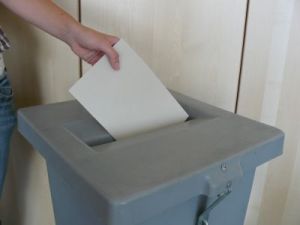In an analysis of the 2009 federal elections, Professor Andranik Tangian from KIT compared positions outlined in the parties’ programs and results of surveys with the results of the elections. His conclusion is that the decision of electors is determined by traditional political attachments rather than by their own political opinion. To bridge this gap, Tangian proposes to introduce a third vote for a political program.
The study of Andranik S. Tangian, Extraordinary Professor at the Chair of Economic Theory (VWL I) of KIT, originated from his lectures on “Mathematical Theory of Democracy” in the 2010 summer semester. It is based on data from the Wahl-O-Mat® of the Federal Center for Political Education and on results of various surveys. On the occasion of the 2009 federal elections, the Wahl-O-Mat® asked the parties for their positions and opinions on more than 30 political topics of current importance. Among them were the introduction of a Germany-wide legal minimum wage or a general speed limit on German highways. Tangian compared these positions of the parties with the results of polls of public opinion and estimated the popularity and universality of the five leading German parties.
The popularity index indicates the fraction of the population represented by the party with regard to its political program. The universality index shows in how many questions the party represents a majority of the population. Both indexes reveal that the representativeness of the German parties significantly deviates from the election results.
Tangian concludes that the decision of the electors is not so much determined by their own opinion on current issues and the parties’ programs. Instead, they decide on the basis of traditional political affiliations, even though these may be outdated. And they are influenced by the personal image of politicians.
Tangian proposes to link representative and direct democracy and to add a third vote for a political program to the first vote for a person and a second vote for a party. To give their third vote, electors shall complete a questionnaire similar to the Wahl-O-Mat® that illustrates their political profile. “This third vote may reduce the gap between reality and outdated conceptions and result in a more efficient democracy,” explains Tangian.
Andranik S. Tangian, Decision making in politics and economics: 4. Bundestag elections 2009 and direct democracy, KIT Working Paper Series in Economics, No. 8, October 2010.
http://econpapers.wiwi.kit.edu
Being “The Research University in the Helmholtz Association”, KIT creates and imparts knowledge for the society and the environment. It is the objective to make significant contributions to the global challenges in the fields of energy, mobility, and information. For this, about 10,000 employees cooperate in a broad range of disciplines in natural sciences, engineering sciences, economics, and the humanities and social sciences. KIT prepares its 22,800 students for responsible tasks in society, industry, and science by offering research-based study programs. Innovation efforts at KIT build a bridge between important scientific findings and their application for the benefit of society, economic prosperity, and the preservation of our natural basis of life. KIT is one of the German universities of excellence.

